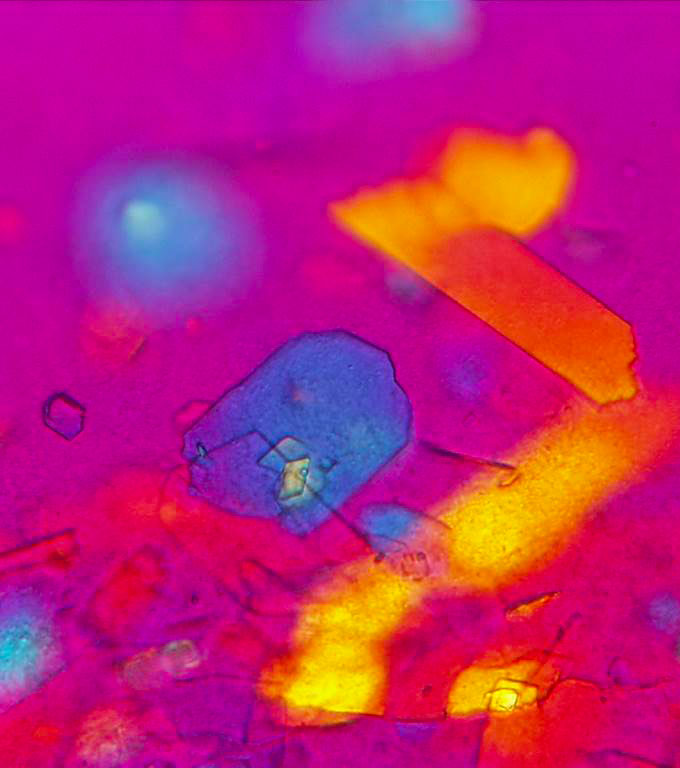Thirst for knowledge

Many years ago, Dr. David Mangelsdorf and Dr. Steven Kliewer worked together as postdoctoral researchers in the Salk Institute laboratory of Dr. Ronald Evans. They then parted ways, one going into industry and the other joining the faculty at UT Southwestern.
At that point, they were fierce but friendly competitors in the same hot area: signal transduction pathways. In 2002, they decided to pool their resources. Dr. Kliewer joined Dr. Mangelsdorf at UT Southwestern to create the Mangelsdorf-Kliewer laboratory. The two are credited with a succession of noteworthy findings on the liver hormone FGF21, or fibroblast growth factor 21, which exerts several striking effects on the body and brain. Among those findings, they showed that the protein β-Klotho is required for FGF21’s effects in animals.
In a 2016 study comparing the genetics of more than 105,000 light and heavy social drinkers, they collaborated with colleagues in Europe to identify a variant in the β-Klotho gene that suppresses the desire to drink alcohol.
In a series of animal studies, Drs. Mangelsdorf and Kliewer showed that:
- Liver-derived FGF21 works via the brain’s reward pathway (the dopamine pathway).
- In mice, FGF21 activation works via the brain to suppress the desire for sweetener- and alcohol-laced water in favor of drinking unflavored water.
- In monkeys, FGF21 also stimulates a preference for pure water over that of water flavored with a noncalorie sweetener.
“The ‘eureka moment’ of the back-and-forth conversation was me saying, ‘Maybe FGF21 regulates water balance,’” he said. “I’ve had like three eureka moments in my life. This is the biggest I’ve had since moving to Dallas.”
Those curious results from animal and human studies led to deep discussion in the Mangelsdorf-Kliewer lab and to what the scientists describe as a breakthrough moment.
UTSW faculty members are trained to trace down the genes and examine why they might be conserved throughout evolution “almost from the time we are in diapers,” Dr. Mangelsdorf – the more outgoing of the pair – jokes. Dr. Mangelsdorf is Chair of Pharmacology, a Howard Hughes Medical Institute Investigator, and a Professor of Pharmacology and Biochemistry. He holds the Alfred G. Gilman Distinguished Chair in Pharmacology, and the Raymond and Ellen Willie Distinguished Chair in Molecular Neuropharmacology in Honor of Harold B. Crasilneck, Ph.D.
Dr. Kliewer remembers a conversation with Dr. Christoph Zechner, now an Instructor in Internal Medicine and Pharmacology, who was then in the University’s Medical Scientist Training Program. The two were discussing the many strange effects the laboratory had observed in the context of FGF21.
“We were talking about kidneys and the different stresses that turn on FGF21 production in the liver, including sugars and alcohol,” says Dr. Kliewer, Professor of Molecular Biology and Pharmacology and holder of the Diana K. and Richard C. Strauss Distinguished Chair in Developmental Biology.
“The ‘eureka moment’ of the back-and-forth conversation was me saying, ‘Maybe FGF21 regulates water balance,’” he says. “I’ve had like three eureka moments in my life. This is the biggest I’ve had since moving to Dallas.”
That led to a series of experiments conducted by Dr. Parkyong Song, a postdoctoral researcher and lead author of the April Cell Metabolism report that explains why drinking alcohol or consuming sugar makes us thirsty. Like the earlier alcohol investigation, this one also included human studies done by European collaborators.
“Unexpectedly, FGF21 works through a new pathway in the brain that is independent of the classical renin-angiotensin-aldosterone thirst pathway that starts in the kidneys,” Dr. Kliewer says.
“We knew that exposure to alcohol or sugar turns on production of FGF21 in the liver. What we now show is that this hormone then travels in the blood to a specific part of the brain, the hypothalamus, to stimulate thirst, thereby preventing dehydration,” Dr. Kliewer said.

In mice, the study revealed, the hormone regulated hydration (water drinking) in response to nutrient stress. In one experiment, the researchers found that normal mice and mice genetically unable to produce FGF21 drank similar amounts of water when given the typical chow diet. However, a high-fat/low-carbohydrate ketogenic diet stimulated water intake in normal mice while mice genetically unable to produce FGF21 failed to drink more water in response to that nutritional stress. Those findings confirmed the hormone’s role in the signaling pathway, the researchers say.
A second important finding in this study is the very strong response to the hormone in humans, Dr. Mangelsdorf says.
In that arm of the study, 21 participants at the Medical University of Graz in Austria were randomly assigned to drink either juice mixed with alcohol or unadulterated juice. Researchers then measured their FGF21 blood levels every hour for four hours. In response to alcohol, FGF21 levels peaked at around two hours and fell after that.
“This result suggests that FGF21 might someday be used as a drug to limit alcohol consumption and protect against its effects in people,” Dr. Mangelsdorf says. The study also suggests that FGF21 is regulated similarly in humans and in mice.
The researchers say this FGF21-induced thirst response appears to depend on another signaling pathway in the hypothalamus, the β-adrenergic circuit. Studies from the 1960s and 1970s suggested that pathway might regulate thirst. If proved true, this would be one of several mysteries Drs. Mangelsdorf and Kliewer have solved.
In 2015, Dr. Kliewer became the third UT Southwestern faculty member honored with the Adolf Windaus Prize for Bile Acid Research at the International Bile Acid Meeting in Freiburg, Germany. Previous recipients were Dr. Mangelsdorf (2000) and Dr. David Russell (2002), Vice Provost and Dean of Research, who holds the Eugene McDermott Distinguished Chair in Molecular Genetics.
Dr. Mangelsdorf describes his partner as a mix of the two scientist characters Leonard and Sheldon on The Big Bang Theory.

Before he and Dr. Kliewer began their partnership, the two competed on the discovery of the long-sought-after mechanism for how the body regulates the catabolism of cholesterol into bile acids, Dr. Mangelsdorf explains. They each won the Windhaus Prize for unraveling different aspects of that mystery. Dr. Mangelsdorf received the prize for identifying the bile acid receptor and its downstream targets in the liver. Dr. Kliewer was selected for the discovery of a hormone secreted by the gut, FGF19, to regulate bile acid metabolism in the liver. Dr. Kliewer began that work prior to arriving at UT Southwestern, and the key study was published in 2005.
“Steve’s finding was the missing link in the feedback loop by which bile acids regulate their own synthesis,” Dr. Mangelsdorf says.
As for the future, the partners predict a shift in thinking about metabolism.
For a long time, feeding behavior has been emphasized in metabolic research rather than hydration. The FGF21 research suggests a change may be on the table, the researchers say.
“To put this in context, we always look at food intake, and the metabolic field has spent comparatively little time studying water intake. Our Cell Metabolism study suggests that we should think more about hydration and how it might contribute to metabolism,” Dr. Kliewer says.
“Stay thirsty, my friends,” Dr. Mangelsdorf adds.

